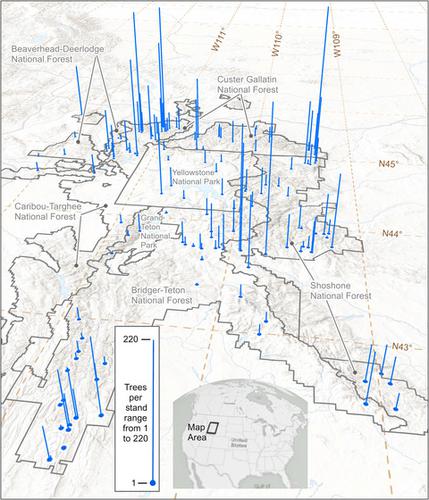当前位置:
X-MOL 学术
›
J. Appl. Ecol.
›
论文详情
Our official English website, www.x-mol.net, welcomes your feedback! (Note: you will need to create a separate account there.)
Adaptive monitoring in action: Reconsidering design‐based estimators reveals underestimation of whitebark pine disease prevalence in the Greater Yellowstone Ecosystem
Journal of Applied Ecology ( IF 5.7 ) Pub Date : 2021-01-18 , DOI: 10.1111/1365-2664.13837 Erin Shanahan 1 , Wilson J. Wright 2 , Kathryn M. Irvine 3
中文翻译:

进行中的自适应监视:重新考虑基于设计的估计量,发现大黄石生态系统中白皮松树疾病的流行率低估了
更新日期:2021-01-18
Journal of Applied Ecology ( IF 5.7 ) Pub Date : 2021-01-18 , DOI: 10.1111/1365-2664.13837 Erin Shanahan 1 , Wilson J. Wright 2 , Kathryn M. Irvine 3
Affiliation

|
- Identifying and understanding status and trends in ecological indicators motivates continual monitoring over decades. Many programs rely on probability surveys and their companion design‐based estimators for status assessments (e.g. Horvitz–Thompson). Design‐based estimators do not easily extend to trend estimation nor situations with observation errors. Field‐based monitoring efforts inevitably have turnover of field crew members which may affect consistency and accuracy of data collection over time. Additionally, design‐based estimators ignore the complexities of spatial and temporal heterogeneity in an ecological indicator and how this variability may be linked to environmental or biological dynamics. We propose monitoring programs should re‐evaluate their prescribed statistical methods, consider model‐based approaches and adapt their sampling designs as needed to improve inferences.
- The Greater Yellowstone Ecosystem, home to two of the most iconic U.S. National Parks, has experienced significant declines in whitebark pine Pinus albicaulis communities due to forest pathogens, insect outbreaks, wildland fires and drought. Whitebark pine is a keystone species found in mountainous environments throughout the Western U.S. and Canada. We assessed the design‐based ratio estimator originally recommended for estimating prevalence of white pine blister rust Cronartium ribicola. We compared the design‐based estimator to a model‐based approach that accounts for the sampling design, imperfect detection and allows for infection probabilities to vary over space and time.
- Ignoring observation errors led to lower estimated prevalence of white pine blister rust in the general population. Using model‐based approaches, we found that the probability of infection has increased since 2004. However, overall prevalence likely has not changed because of the mountain pine beetle Dendroctonus ponderosae‐induced shift towards smaller diameter trees that have a lower probability of infection compared to their larger cohorts.
- Synthesis and Applications. Using a design‐based approach to detect change in ecological indicators falls short because of the inability to account for observation errors or to explore environmental or biological factors explaining temporal dynamics. Inherently understanding the mechanisms leading to changes in an ecological indicator over time informs potential management actions. Our assessment underscores the need for continued evaluation and updating of a monitoring program's sampling design and analytical procedures to maintain relevancy.
中文翻译:

进行中的自适应监视:重新考虑基于设计的估计量,发现大黄石生态系统中白皮松树疾病的流行率低估了
- 识别和理解生态指标的状况和趋势促使人们持续进行数十年的监测。许多程序依赖于概率调查及其基于设计的伴随估计器来进行状态评估(例如Horvitz-Thompson)。基于设计的估计器不容易扩展到趋势估计或存在观察误差的情况。基于现场的监测工作不可避免地会增加现场工作人员的流动率,这可能会随着时间的推移影响数据收集的一致性和准确性。此外,基于设计的估算器会忽略生态指标中时空异质性的复杂性,以及这种可变性如何与环境或生物动力学联系起来。我们建议监控程序应重新评估其规定的统计方法,
- 在大黄石生态系统,拥有两个最具代表性的美国国家公园的,经历显著跌幅白皮松松albicaulis社区由于森林病原体,虫害爆发,野火和干旱。白皮松是在美国西部和加拿大的山区环境中发现的主要树种。我们评估了最初推荐的基于设计的比率估计器,该估计器用于估计白松水泡锈病Cronartium ribicola的患病率。我们将基于设计的估计量与基于模型的方法进行了比较,该方法考虑了采样设计,不完善的检测并允许感染概率随空间和时间而变化。
- 忽略观察错误会导致一般人群中白松水泡锈病的估计患病率降低。使用基于模型的方法,我们发现自2004年以来感染的可能性有所增加。但是,总体流行率可能没有改变,这是因为山松甲虫Dendroctonus pokerosae导致向直径更小,感染可能性更低的树木的转移。他们更大的队列。
- 综合与应用。由于无法解决观测误差或无法探索解释时间动态的环境或生物因素,因此使用基于设计的方法来检测生态指标的变化很短。内在地理解导致生态指标随时间变化的机制,可以指导潜在的管理措施。我们的评估强调需要持续评估和更新监控程序的采样设计和分析程序,以保持相关性。


























 京公网安备 11010802027423号
京公网安备 11010802027423号